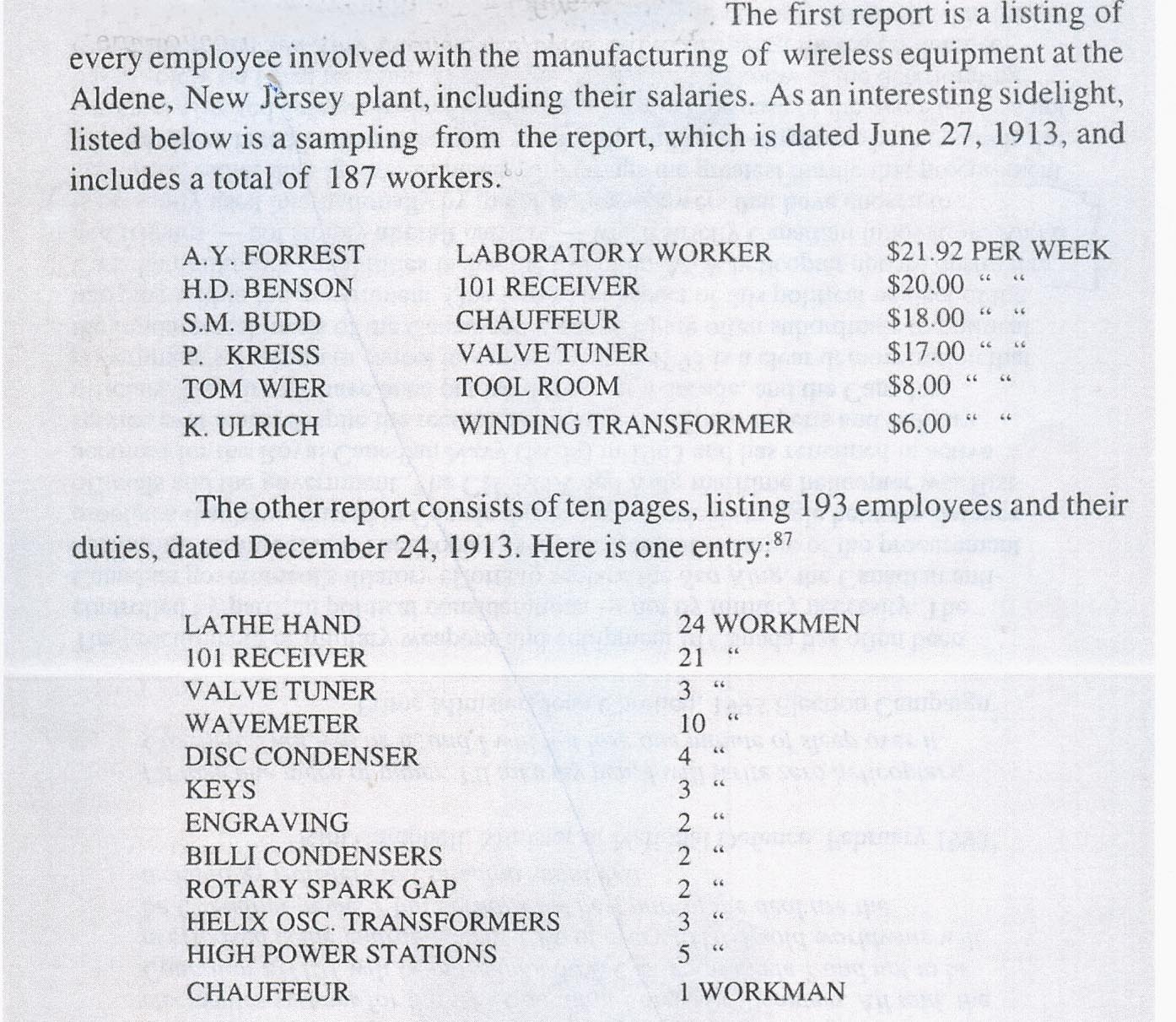It wasn't until 1912 that manufacturing facilities were finally acquired by the Marconi Company in the U.S. Previously the main purpose of the American company had been to conduct a wireless s telegraph service specifically with ships along the east coast. By 1901, a few German and English transatlantic liners were equipped with wireless apparatus making it necessary to build stations along the coast. Initially, only the Nantucket and the Babylon Long Island stations were erected. They carried on a fine business transmitting messages from passengers when ships were near shore, or wIth the various Marconi stations located along the transatlantic run.The first Chief Engineer of the American company was W.W. Bradfield, succeeded by Frederick Sammis in 1908. By 1904 J J. Brennan had come to the Marconi New York hop as a machinist, and continued as, head of the machine shop after the RCA merger. He personally built many items of equipment for Henry Round while a technician, a well as made-to-order apparatus for Marconi. Although the original intention was to perform all the manufacturing in England, the high import duty on complete sets persuaded them to ship finished but unassembled parts duty free, or nearly so, and assemble them in New York.
They needed a small New York shop to make occasional repairs to equipment on the ships and also make repairs to land stations, a well as a storeroom for parts and equipment. The Front Street attic shop and later 37 Water Street served this purpose and occasionally when Guglielmo Marconi was in the US, he wanted special apparatus made, for he was continually experimenting and developing new ideas. The New York shop also built special parts for South Wellfleet for tests. These shops had a small lathe and assembly benches but were essentially used for repair.
Most metal parts were imported from Chelmsford, England, using standard English Marconi style apparatus. Wood work was performed by Bubek and Guerin on 18th Street, while special metal work and castings were done by the Manufacturers and Inventors Electric Company on Gold Street near the Marconi shop. Transformer cases, square forms for early oscillation transformers, and later loading coil forms were made a few at a time in the cabinet shop and assembled at the Marconi shop.
Up until about 1910 American Marconi was a very small company which operated very economically. Some American operators used to call it "That Cheap Dago Push Cart Wireless Company." True, some of the shops including Seattle did have ordinary vegetable peddlers' push carts for emergency use to take parts to a ship in a hurry.
As of 1905., there were six or eight people in the New York office, and two in the shop. With the operators at the four coast stations, there was a total of about 25 employees in New York.
One of the Marconi reports which was found while searching the George Clark Radioana collection listed every employee involved with the manufacturing of wireless equipment at the Aldene, New Jersey plant including their salaries. As an interesting sidelight, listed below is a sampling from the report, which is dated June 27, 1913, and includes a total of 187 workers.
 |
| During 1914, the new Marconi works at Aldene, N.J., was very busy bringing out many new designs, among them the 1/2, 2 and 5kW, 500 cycle quenched gap transmitters. |
In the 1914 era, American Marconi did not sell radio apparatus to private users . Most ship installations were on the basis of $1,000 per year rental.By the end of March, 1915, the Marconi Company had 225 coast stations and 1,894 ships equipped with their wireless apparatus.The Aldene plant provided all the apparatus accompanying receivers and transmitters, such as spark gaps, telegraph keys. wavemeters, antenna switches, and Leyden jars. The last series of receivers was produced for the Signal Corps in 1918 and 1919 and were designated Types 120, 121 and 122. They are identical in appearance, differing only in wavelength. As an example, the Type 120 covered 50 to 225 meters, while the Type 122 covered 175 to 775 meters.
The American Marconi Company was nearing its heyday. Over a quarter of a million commercial messages were sent in 1915. This traffic was brought almost to an absolute standstill, however, in early 1917.when war with Germany was declared. All wireless stations were affected. either by being completely shut down or put under United States Na y control.
At the time 540 ships had Marconi apparatus. The U.S. Navy took over 370 ocean going vessels. Although the remainder were left in Marconi' s control. The vast majority of the communications business was crippled. The Aldene factory was to take up the slack through manufacturing. It doubled in size during the summer of 1917, accommodating the orders for wireless equipment to outfit the Army and Navy. Employee growth more than tripled from 200 to 700.
The first million dollar contract was awarded for 400 1/2kW, 500- cycle spark transmitters (Type Clvl 296A) to equip submarines. Larger transmitters were later ordered for battleships and destroyers, while portable units were requested for truck and field use. Equipment sales grew to an all time high of $7,000,000 by 1918.
The Armistice was signed in November, 1918, signaling a change in the wireless communication business in the United States. By November of 1919, one year after the end of the war, the American Marconi Company had reached the end of its life; The formation of RCA was imminent.
Credits and References:1) Jim Kreuzer`s chapter on American Marconi from his article
" Marconi -The Man and His Apparatus" , printed in the AWA Review vol. 9 1995
Oct 20/20